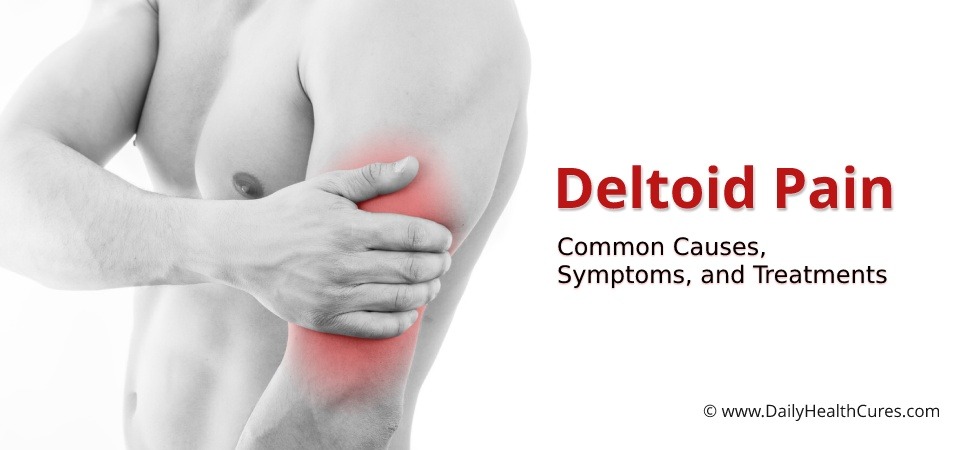Deltoid Pain: Causes, Symptoms and Home Remedies

Deltoid pain is uncomfortable and can impede with shoulder and arm mobility. Deltoid muscle pain ranges from mild to severe.
Regardless of the level of pain, individuals tend to seek treatment right away to stay active. Usually, deltoid strains are the result of excess pressure or load on that muscle.
This type of tension is prevailing in repetitive activity or sports, such as using power tools or playing baseball. These strains are common because the deltoid is connected to the shoulder muscle, and it dictates arm movement in all directions. Let’s see the common symptoms, types of pain, causes, and treatments of deltoid pain.
Related Reading: Unexplained Bruises on The Legs: Common Causes and Treatments
Symptoms Associated with Deltoid Pain
Here are signs and symptoms that come with deltoid pain:
- Pain while lifting arm, pain that radiates from tip of the shoulder to upper arm
- A weakness of the shoulder
- Difficulty or pain in lifting objects
- Sharp pain when pushing or pulling objects
- Pain decreases when the arm is at rest
Types of Deltoid Muscle Pain and Their Symptoms
There are three different grades of deltoid pain, ranging from one to three. The deltoid pain is classified according to the severity of the injury.
Grade 1: At this level, there is mild tightness and pain in the shoulders. Individuals can still utilize their shoulders for movement and activities. There is minimal swelling of the deltoid muscle. Lifting the arm up, sideways, or front and back of body will not be much painful.
Grade 2: Major injury to the deltoid muscle is the indicator of this level. A partial rupture could be present in the tissue. Individuals experience increased pain and complications using their shoulders; for example, a person may not be able to do a press up. Swelling in the deltoid region might be noticeable. Lifting and moving the arm in different directions as well as pressing up creates a significant amount of pain.
Grade 3: A complete rupture is most likely in the case of level three pain. Severe pain is known, and individuals cannot use their shoulders. Significant swelling of the deltoid is also present, and a bulge or gap in the muscle might be noticeable. An individual can expect to be out of athletics or activities for up to 12 weeks.
Deltoid Pain Causes
There is a correlation between deltoid pain and specific activities. Some of the deltoid muscle pain causes are mentioned below:
- Swimming
- Skiing
- Lifting heavy weights
- Using heavy tools with hands
- Repeated throwing
- Repetitive typing when proper ergonomics are not practiced.
- Carrying children.
Besides these typical activities, there are trigger points that could prompt pain in the deltoid. Trigger points cause sensitivities to the body. Some of these factors include:
- Falling on the shoulder.
- Overloading the body, such as reaching out to catch a fall.
- Using power tools.
- Any repetitive activity with the hands and shoulders.
Being aware of the activity and knowing how it can impact the body can prevent deltoid pain.
Deltoid Muscle Pain Treatment
There are a few deltoid pain treatment methods that can alleviate the pain. Deltoid pain treatments include the RICE method, certain therapy wraps, and self-massage.
Doctors, trainers, and other medical professionals recommend the RICE (rest, ice, compression, and elevation) method for recent injuries, swelling, chronic pain, and avoidance of re-injury. All levels of shoulder and deltoid pain are treated with traditional techniques, such as over the counter medicines. Ibuprofen and Tylenol are used to reduce inflammation and manage pain. There are rare cases where surgery is needed.
Ice and gel packs tend to cause ice burn to the skin. These things can be used to treat strained deltoid muscles.
The Leg/Arm ColdCure Wrap was recently released, and its purpose is to treat the shoulder area more efficiently than standard ice or gel packs. This new cold compress therapy slows nerve and cell function in the injured area. This process reduces the swelling which blocks blood flow. Also, individuals do not need to worry about uncomfortable ice burn on their skin.
The cold cure wrap allows blood flow which is essential for healing. Blood flow brings oxygen and nutrients to the injured area so that it can start the process of healing.
BFST For Deltoid Pain Relief
Another deltoid pain relief method is Blood Flow Stimulation Therapy (BFST). It speeds up blood flow to the shoulder area to prepare it for exercising. BFST increases the amount of blood flow to a particular area to hydrate the tendons, ligaments, and muscles. This type of therapy creates elasticity and improves the healing process.
Using a cold cure wrap and BFST are essential because it reduces the amount of damage done to the deltoid muscle. Decreasing the amount of damage also decreases the timeline for healing.
Deltoid pain exercises and self-massage with a massage ball are another effective methods to try at home. The massage ball can be used on the front, middle, or back of the shoulder. To use a massage ball, just press and roll the ball against the muscles until the trigger spot has been found. Work the ball on the tender spot once it is found.
Depending on the extent of the injury the time to heal deltoid pain will vary. A strained muscle can take one week to recover while in case of serious injuries it can take up to three weeks.
Read Next:
- Stomach Gurgling: Common Causes and Home Treatments
- Unexplained Bruises on The Legs: Common Causes and Treatments
Sources:
“Deltoid muscle pain: Symptoms, causes, and pain relief tips,” https://www.belmarrahealth.com/deltoid-muscle-pain-symptoms-causes-pain-relief-tips/, last accessed October 24, 2017.
“Deltoid Muscle Strain,” Sports Injury Clinic web site; http://www.sportsinjuryclinic.net/sport-injuries/shoulder-pain/deltoid-muscle-strain, last accessed October 24, 2017.
“Deltoid Muscle Strain,” Aidmymuscle web site; http://www.aidmymuscle.com/shoulder/deltoid-strain.php, last accessed October 24, 2017.
“Deltoid muscle pain & trigger points,” Muscle Joint Pain web site; https://www.muscle-joint-pain.com/trigger-points/trigger-point-self-treatment/deltoid/, last accessed October 24, 2017.
